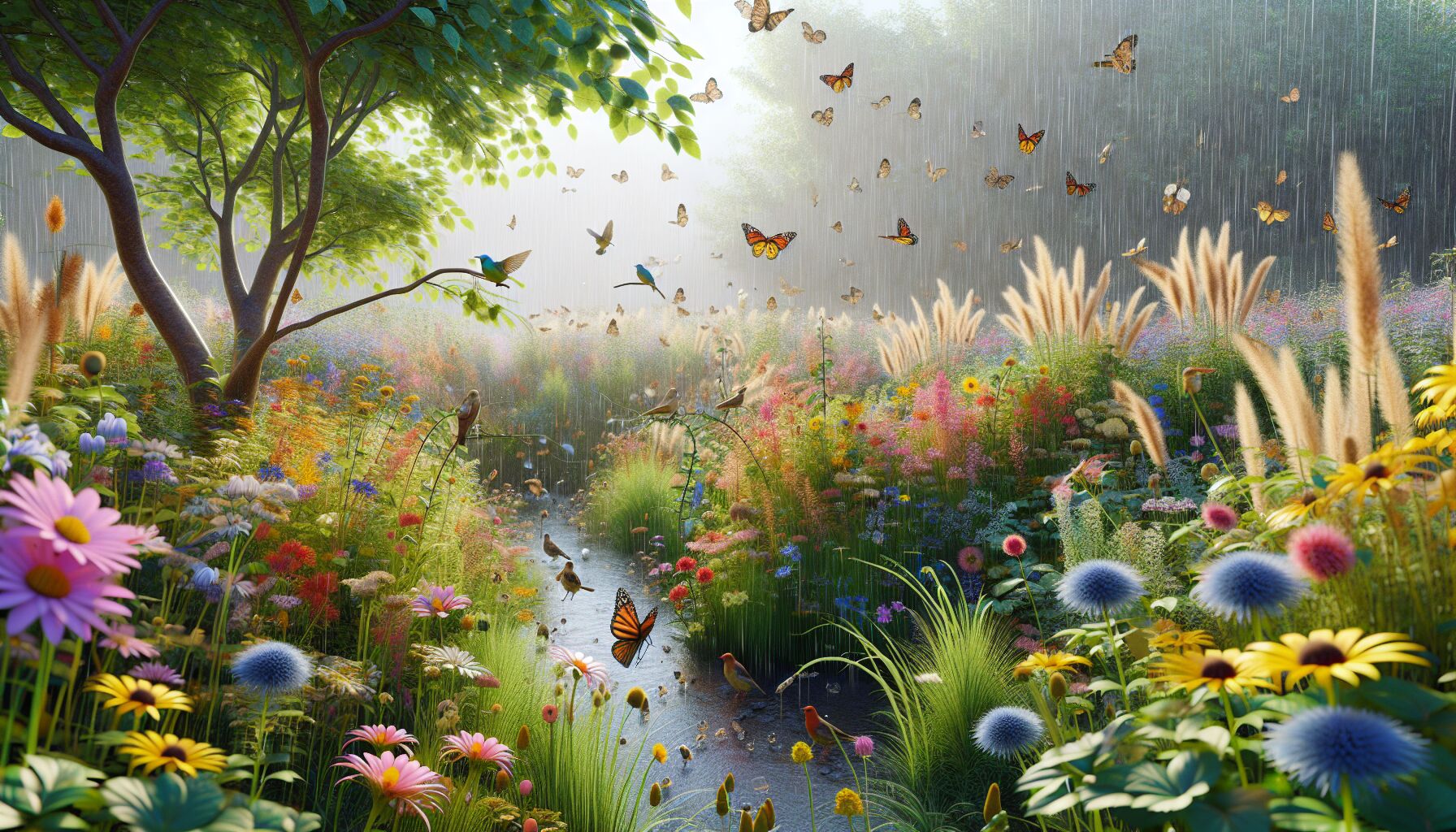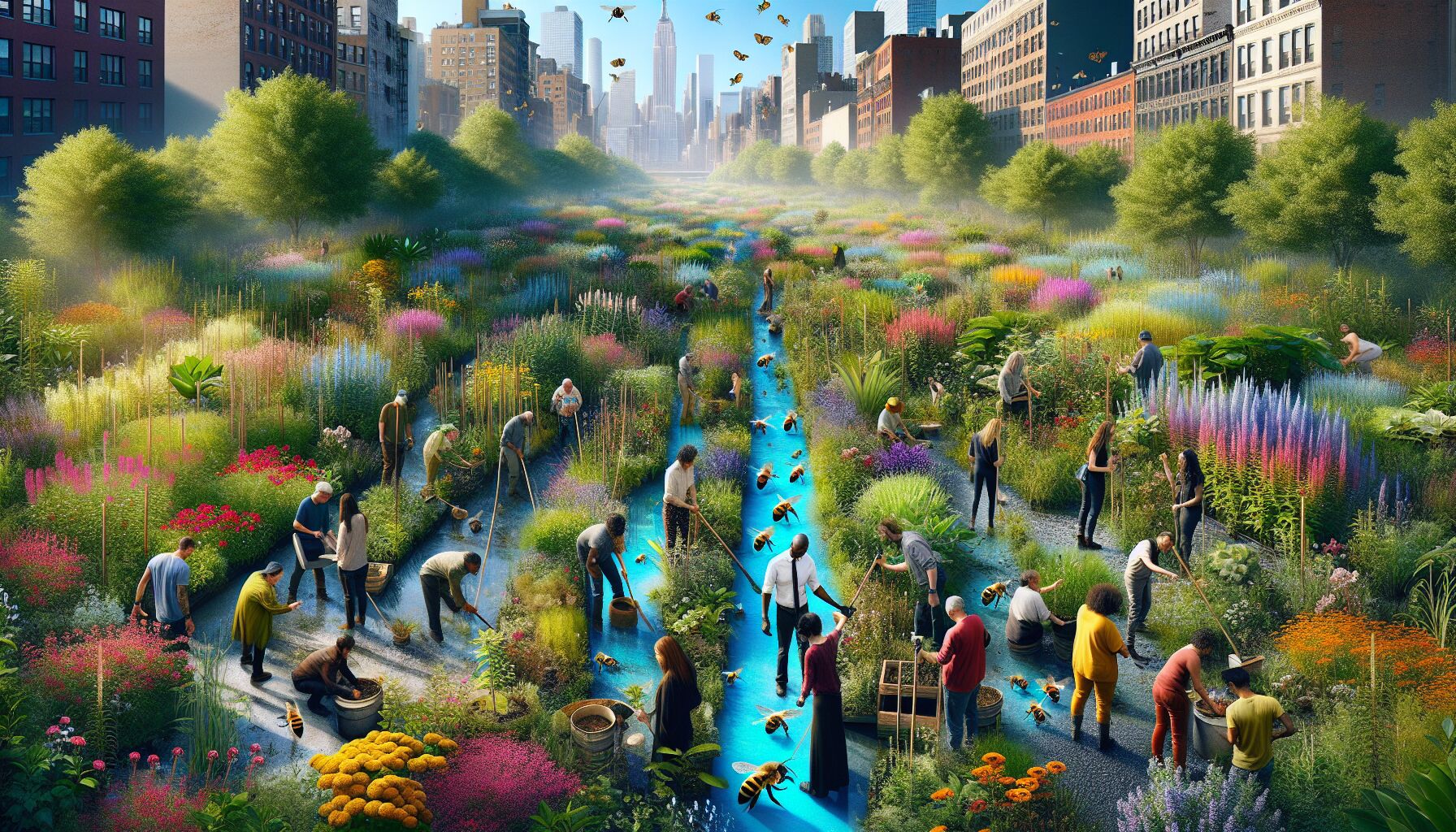 Rain gardens are a humble yet powerful testament to the art of letting nature do what it does best. In urban environments buzzing with concrete and artificial constructs, these verdant patches serve as nature’s quiet rebellion, emphasizing the harmony between human habitation and the natural world. They offer a gentle nudge, urging us to remember the earth’s pulse beneath our feet.
Rain gardens are a humble yet powerful testament to the art of letting nature do what it does best. In urban environments buzzing with concrete and artificial constructs, these verdant patches serve as nature’s quiet rebellion, emphasizing the harmony between human habitation and the natural world. They offer a gentle nudge, urging us to remember the earth’s pulse beneath our feet.
At the heart of their environmental impact is the magic of green infrastructure—a term that marries the organic with the engineered. Unlike the rigid gray structures so common in cities, rain gardens harness the natural processes of absorption, filtration, and transpiration. They act like living sponges, soaking up stormwater, reducing runoff that otherwise would burden aging city drains. This is not merely about water; it’s about nurturing spaces where life thrives above and below ground.
With each downpour, a rain garden becomes a sanctuary for local flora and fauna. They bring together a myriad of plant varieties, from deep-rooted grasses to vibrant wildflowers, creating a mini-ecosystem right in the heart of urban jungles. This diversity does more than paint a pretty picture. It provides bustling habitats for pollinators, like butterflies and bees, and becomes a refuge for birds seeking shelter. As these gardens flourish, they support insect populations, which in turn sustain birds and small mammals—each element interwoven with the other, a circular dance of life.
But you might wonder why these details matter in the wider scheme of things. Well, it’s a ripple effect. Healthy ecosystems contribute to environmental resilience, a bulwark against the unpredictable nature of climate change. Consider this: by supporting just one rain garden, a city can enhance oxygen production, offset carbon footprints, and even regulate temperatures—offering cooler spaces amid the urban heat.
Surprisingly, these gardens have another ally: us. Human curiosity often leads to unexpected participation and engagement, drawing communities into the fold of environmental stewardship. As we cultivate these spaces, we’re reminded of Aldo Leopold’s insight: “The land ethic simply enlarges the boundaries of the community to include soils, waters, plants, and animals, or collectively: the land.” In this shared venture, humans, plants, and animals alike are woven into a larger tapestry of interconnected existence.
By mimicking natural processes, rain gardens don’t just improve our immediate surroundings; they teach us patience, observation, and reverence for life’s delicate balance. We gain more than just practical flood control; we gain insight and a piece of everyday tranquility.
Stormwater management and flood prevention
There’s something almost poetic about watching rain trickle down into a rain garden. Amidst the urban sprawl, these serene patches offer a solution to one of today’s most pressing challenges: managing stormwater and preventing floods. Let’s face it, with climate change altering weather patterns, cities are often caught unprepared against sudden deluges. Traditional drains can only handle so much before overflowing, leading to flood-ravaged streets and exaggerated erosion. This is where rain gardens step in, functioning as nature’s own flood control specialists.
Think of these gardens as nature’s sinkholes, engineered not to trap, but to slowly filter rainwater back into the earth. Rain gardens, part of green infrastructure, act like catchment basins, capturing excess stormwater from roofs and streets, then allowing it to slowly percolate through layers of soil and gravel. This process doesn’t just stop flooding; it replenishes groundwater, a crucial reserve often overlooked in urban planning.
Have you ever noticed how natural landscapes barely flinch during a storm, whereas cities reel from even moderate rain? The secret lies in the soil beneath trees and plants, soaking up excess water like a sponge. Rain gardens replicate this phenomenon, highlighting nature’s effectiveness. They slow down water flow, reducing the risk of flash flooding and erosion, particularly important as impermeable surfaces multiply in cities. By doing so, they alleviate stress on existing municipal drainage systems, which can be overwhelmed by large volumes of rapid runoff.
But the benefits extend beyond just stormwater management. Rain gardens improve water quality too. As stormwater seeps through these garden beds, they capture pollutants carried from roads and sidewalks, acting like natural water filters. This thorough cleansing ensures that when water eventually joins streams and rivers, it’s significantly cleaner. You could say that rain gardens embody the principle of working with nature, not against it.
It’s strange—our world relies either on high-tech solutions or dismisses problems as unsolvable. Rain gardens challenge both notions, demonstrating that sometimes the answers lie in simplicity and integration with the natural world. As cities strive to become more resilient, incorporating green solutions like rain gardens reflects a shift towards creating urban landscapes that are not only sustainable but harmoniously integrated with nature’s rhythms.
With every storm that passes and leaves behind dry, unobstructed streets, the subtle power of rain gardens is unmistakable. They show us a path forward, one that respects the environment while addressing contemporary urban challenges. As you walk by one of these unassuming spaces, remember the profound role they play in reclaiming balance between manmade structures and the natural world. Why not pause for a moment and appreciate their quiet strength in a storm’s wake?
Community engagement and urban beautification
 There’s a certain charm in how rain gardens transform urban spaces, turning the concrete chaos into vibrant pockets of life and color. Picture this: a plot of land surging with native plants, buzzing with bees, and echoing the chirps of birds. These gardens aren’t just green patches meant to absorb water; they’re social catalysts igniting community engagement and urban beautification. Could there be a better remedy for a city’s soul, weary from the ceaseless hum of urban life?
There’s a certain charm in how rain gardens transform urban spaces, turning the concrete chaos into vibrant pockets of life and color. Picture this: a plot of land surging with native plants, buzzing with bees, and echoing the chirps of birds. These gardens aren’t just green patches meant to absorb water; they’re social catalysts igniting community engagement and urban beautification. Could there be a better remedy for a city’s soul, weary from the ceaseless hum of urban life?
Rain gardens breathe new life into neighborhoods, often becoming the centerpiece of both community efforts and municipal projects. As residents come together to cultivate these spaces, a unique camaraderie forms—a shared goal that transcends individual interests. It’s like planting the seeds not just for greenery, but for genuine human connection. A rain garden becomes everyone’s garden, a project that invites involvement regardless of age or background, crafting a shared story told through the growth of wildflowers and shrubs.
There’s something deeply satisfying about contributing to a space that garners admiration and use within a community. Residents organize planting days, educational workshops, and even seasonal festivals around these verdant havens. These gatherings offer more than just manual labor; they’re opportunities to learn, share stories, and eventually, celebrate achievements together. Rain gardens serve as a reminder that collaboration doesn’t have to be earth-shattering to be meaningful. As the plants flourish, so do relationships, weaving a rich tapestry of social bonds—a cornerstone of community health.
Urban beautification thanks to rain gardens isn’t just about aesthetics, although they do create an undeniably welcoming environment. It’s about altering perceptions and breaking down the barriers between people and nature. By integrating these gardens into daily life, cities can transform drab areas into lively hubs, reducing urban blight and increasing property values. Why slot rain gardens into another box labeled “environmental initiative” when their potential stretches far beyond?
A fundamental shift occurs when a neighborhood sees itself reflected in a landscaped space—a touch of pride, a surge of mindfulness. These gardens sway perceptions, reminding us that sustainable urban development is achievable, one plot at a time. They act as living classrooms, sparking curiosity about local ecology and fostering environmental stewardship in every visitor. In this age of digital distractions, watching nature unfold can offer a serene pause, an invitation to engage with the real world rather than a virtual one.
As various cities embrace rain gardens, their popularity encourages a ripple effect, incentivizing other neighborhoods to take the leap. Sharing success stories, swapping plant advice, and inviting local media to highlight these vibrant projects all feed into a cycle of inspiration and motivation.
You’ll find that these gardens become markers of both transformation and resilience. In a world dominated by gray spaces, allowing bursts of color and life asserts that beauty and practicality aren’t mutually exclusive. Rain gardens rally us to reclaim nature’s essence, inviting it in as a fellow city dweller, a partner in our journey toward sustainable, flourishing communities. They subtly remind us of our role in nurturing the world’s pulse beneath our feet, one rain-washed blossom at a time.
By intertwining practicality with aesthetic allure, rain gardens do more than halt stormwater in its tracks or adorn cityscapes; they foster a tangible bond between people, plants, and place, resonating as an emblem of adaptive urban futures.
 DS Haven In Light Of Things
DS Haven In Light Of Things






